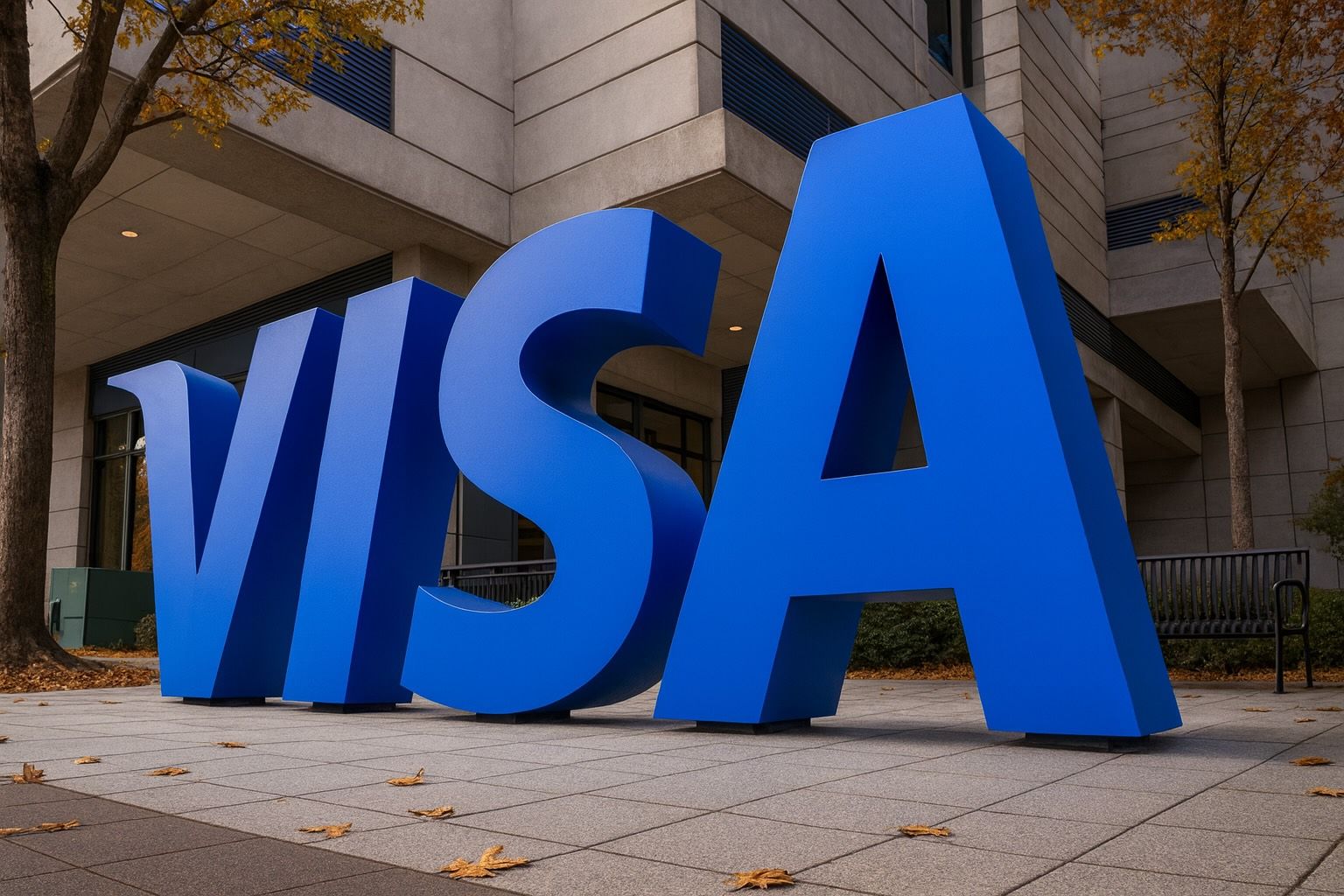- Visa share price (~$341): Visa (NYSE: V) closed around $340.74 on Oct 31, 2025 (the last trading day) [1]. That’s near the top of its 52-week range (~$280–$375) and represents roughly a 10% year-to-date gain [2] [3]. After reporting earnings on Oct 28, shares were about flat at $346–347, then ticked modestly higher (≈+0.6%) in after-hours [4] [5]. Overall, Visa has roughly kept pace with the market in 2025 – up high-single-digits vs. the S&P’s mid-single-digit rise [6] [7].
- Quarterly earnings & dividend: Visa’s fiscal Q4 2025 (quarter ended Sept. 30) delivered strong results [8]. Net revenue rose about 12% year-over-year to ~$10.72 billion, and adjusted EPS was $2.98 (slightly above the ~$2.97 consensus) [9] [10]. The company also hiked its quarterly dividend 14% to $0.67 [11] – a sign of confidence in cash flow. Management noted that consumer spending (even for travel and cross-border transactions) remained robust [12] [13].
- Bullish analyst outlook: Wall Street remains broadly positive on Visa. Analysts rate V mostly as a “Buy/Strong Buy”, with a consensus 12-month target around $389–$400 [14] [15] (implying ~10–15% upside). In fact, MarketBeat reports an average price target of $400.00 [16] from 26 analysts. Major brokerages have set targets in the $400+ range: for example, Bank of America raised its Visa target to $410 [17], Deutsche Bank initiated coverage at $410, and UBS values Visa at $425 (Buy) [18]. (Even Wells Fargo recently dubbed Visa one of the “Fab 5 of Fintech” [19].) The stock’s forward P/E is around 32–33× [20], a premium to the broader market and peers – but many analysts see that as justified by Visa’s network strength and steady growth potential. Notably, Mastercard (MA) trades even higher (~37×) after its own double-digit growth [21] [22].
- Fintech innovation & partnerships: Visa is aggressively expanding into new payment technologies. In late September it launched a pilot program using USDC stablecoins for cross-border B2B payments [23]. Under this pilot, businesses can fund Visa transactions with U.S. dollar–pegged crypto (USDC), which can unlock capital and speed transactions once regulatory conditions are right [24] [25]. Visa’s Head of Commercial Money Movement noted that recent U.S. legislation provided the “regulatory clarity” needed for this trial [26]. The company also rolled out a new “Trusted Agent” AI protocol on Oct. 14 – a security framework to help merchants verify legitimate AI shopping bots [27]. As one analyst put it, Visa is “aggressively investing in new payment technologies” to stay at the cutting edge [28]. Visa has also struck deals to embed its network into travel (e.g. a Booking.com/HotelRunner partnership) and fintech platforms, aiming to drive more volume [29] [30].
- Macro tailwinds: Visa’s business benefits from broader economic trends. In late October the U.S. Federal Reserve cut interest rates by 25 basis points [31] (after a similar cut in September), signaling a more dovish stance. Lower interest rates tend to boost borrowing and consumer spending – a positive for Visa’s credit/debit volumes [32]. Indeed, despite some recent slack in consumer confidence, high-income households have kept spending robustly [33] [34]. U.S. unemployment remains low and wages are rising, which has sustained healthy credit card usage even amid moderate inflation [35]. All else equal, Visa should see continued volume growth if the consumer stays resilient (the company noted “no meaningful impact” on spending from tariffs or inflation [36]). On the flip side, any signs of broad consumer weakness or slower card spending could weigh on the stock – an issue analysts will watch as the holiday season approaches.
- Competition & sector trends: The payments space is strong but competitive. Visa’s main rival Mastercard (MA) is trading near record highs (~$570) after reporting double-digit growth [37]. American Express (AXP) – with a premium-card focus – just saw 11% revenue growth and healthy EPS gains [38]. In fintech, PayPal (PYPL) recently beat Q3 estimates and jumped >6% on Oct. 28, as it expands into AI payments [39]. All these peers highlight the robust demand in payments. Notably, Visa still has the largest global network. Its valuation (mid-30s P/E) reflects that dominance; by comparison PayPal trades in the teens [40]. Investors will balance Visa’s premium vs. its resilient growth: as one analyst noted, Visa’s unchanged guidance in Q3 implied “a deceleration in revenue growth” [41], but the actual Q4 results show it beat that conservative outlook with double-digit revenue gains.
- Regulatory risk: A key overhang is government scrutiny of payment fees. The DOJ has sued Visa (and Mastercard) alleging anticompetitive swipe fees on debit transactions. Visa strongly disputes these claims. As General Counsel Julie Rottenberg stated, competition in the debit market is “thriving” and the DOJ’s claims are “meritless” – Visa will “contest them vigorously” [42]. Investors will monitor how this lawsuit (and related merchant litigation) evolves. So far Visa has set aside some reserves for legal costs, and management insists that these suits have not impacted consumer spending or its business strategy.
Earnings and Business Performance
Visa’s late-October earnings confirmed solid momentum. Fiscal Q4 (ended Sep. 30) topped expectations on both sales and profit. Revenue of $10.72 billion was up 12% year-over-year [43] [44], driven by higher global payment volumes and recovering travel-related transactions. Adjusted EPS was $2.98 [45] [46] – marginally above the consensus ~$2.97 – reflecting tight expense control and higher transaction fees. Management emphasized that consumer usage held up well: Visa noted “significant growth” in processed transaction counts alongside the 12% revenue gain [47] [48].
In tandem with earnings, Visa’s board boosted the quarterly dividend 14% (to $0.67) [49]. That dividend hike underscores the company’s strong cash flow generation. Visa ended FY2025 with record earnings (full-year EPS ~$11.47) and roughly $11 billion in free cash flow – enabling capital returns. For context, Visa saw over $14 trillion in annualized payments volume in FY2025 [50] [51], and much of its revenue growth came from “value-added services” (advisory, data analytics) and expanding issuer fees. Its executive team notes that even as the Fed raised rates and inflation ticked up, consumer spending on cards (especially digital and cross-border) remained resilient [52] [53]. CEO Ryan McInerney specifically pointed out that Visa saw “no meaningful impact” on customer spending from tariffs or higher prices [54], aligning with broader data showing upper-income spending holding steady [55].
Comparing quarters: Visa’s Q3 (fiscal Q3 2025, ended June) had similar beats – revenue +14% to $10.17B and EPS $2.98 [56] – and management emphasized ongoing strength in consumer payments. For the full fiscal year 2025, Visa logged ~11% net revenue growth (~$40B total) and 14% EPS growth to $11.47 [57] [58], despite a cautious guidance signal. The Q3 guidance had been only low single-digit growth, which some analysts (e.g. RBC) read as a conservative tone [59]. But with Q4’s double-digit growth, Visa comfortably cleared that bar. In sum, Visa’s fundamentals remain robust: transaction volume growth (over 8% YOY) and rising revenue per transaction have offset inflation pressures and weaker categories.
Analyst Commentary and Outlook
Wall Street commentary reflects this strength. RBC Capital Markets, for example, noted that Visa’s unchanged full-year guidance “implies a deceleration in revenue growth” – a factor that briefly pressured the stock [60]. But most analysts view Visa’s outlook as solid. Marcin Frąckiewicz at TS2 summarized the consensus: of the two dozen analysts covering Visa, the average rating is “Strong Buy” with a ~$389 12-month target [61]. 24/7 Wall St., in its estimates, expects Visa around $374 by end-2025 and above $400 in the following year.
Recent analyst actions highlight the optimism. MarketBeat (11/2/2025) reports 17 buys, 4 strong buys (5 holds) among 26 analysts [62] [63]. The firm’s consensus target is $400 (implying ~17% upside) [64]. Raymond James on Oct 29 raised its target to $408 [65]. Citigroup in late Oct initiated Visa with a “strong-buy.” Even after a brief post-earnings dip, analysts emphasize Visa’s network effects and consumer spending resilience as key advantages [66] [67]. The long-term story – continued shift to cashless payments globally and Visa’s innovations – keeps price targets lofty (UBS’ latest $425, BofA $410, etc. as noted above).
Technically, Visa’s chart is mixed. After the Oct 28 earnings reaction, the stock stalled near its 50-day moving average (~$346) [68]. According to Investing.com, Visa’s 14-day RSI is about 42 [69] – below the 50 midpoint, signaling mild bearish momentum. Most short/medium moving averages (10–200 day) currently yield “Sell” signals, with the 50-day (~$345.7) and 200-day (~$344.9) MAs sitting just above the current price [70]. In practice, this means Visa is trading slightly below its recent moving averages. Key technical support is around the low-$330s; resistance is at the high-$340s. A decisive move above ~$347 (the Oct. 28 peak) could flip sentiment more bullish, whereas a break below ~$335 would raise fresh concerns. For now, the chart shows no major reversal pattern – the trend is roughly sideways-to-up for the year, with volatility around news events.
Sector and Competitive Landscape
Visa operates in a hot payments sector. The broader fintech and cards industry is enjoying strong tailwinds. Consumers have resumed travel and big-ticket spending, benefiting cross-border volumes. Major card networks and issuers are reporting double-digit growth: e.g. Mastercard’s Q2 volume was +17% YOY and AXP’s revenue jumped 11% in Q3 [71]. Payment stocks have rallied year-to-date: Visa itself is up ~10%, MA and AXP also in positive territory. Beyond the legacy players, fintech innovators like PayPal are also thriving – PYPL’s Q3 beat and revived dividend sent it surging on Oct 28 [72]. All this suggests robust consumer demand for digital payments overall.
In this competitive arena, Visa’s strengths are its scale and diversity. It earns not only traditional swipe fees but also growing revenue from data services, consulting, BNPL partnerships, and international remittances. For example, Visa Direct (push-payments) volume is growing ~27% YOY, and advisory services revenue is up ~23% [73]. Cross-border (international) volume was up ~12% constant-currency in Q4 [74], reflecting recovering global travel. The company’s recent fintech moves (crypto, AI) also help it stay relevant against new entrants.
However, Visa trades at a premium valuation (mid-30s P/E) precisely because of these expectations [75]. If any headwinds emerge (e.g. slower consumer credit growth, or more discounting from merchants), some see limited upside. As TS2 analysts noted, Visa’s high P/E relative to the market and even Mastercard means the stock needs continued execution and volume growth to justify it [76]. For now, confidence is high: over 80% of Visa shares are held by institutions, and investors appear adding to positions [77].
Macroeconomic Outlook
The macro picture is mixed but generally favorable for Visa. U.S. inflation has cooled from highs, and the Fed’s pivot (two rate cuts in Sept and Oct) is aimed at supporting growth [78]. As long as inflation settles and employment stays strong, consumers will keep spending – a direct boost to Visa’s volumes. The recent government shutdown (pending resolution) delayed some economic data, but no significant shock has hit card spending. Consumer confidence did slip in late Oct to a 6-month low [79] (tariffs and higher prices were cited), but high-income consumers in particular remain upbeat [80].
Looking ahead to holiday season (Nov–Dec), Visa traditionally benefits from retail and travel shopping. Economists expect solid holiday sales, supported by wage growth, which bodes well for Visa. Conversely, any rapid Fed tightening or consumer credit crunch would be a risk. For now, most forecasts see moderate GDP growth and another Fed rate cut not yet certain by year-end [81]. Visa management itself assumes a stable consumer backdrop when guiding. In Q4 they reaffirmed that full-year 2026 net revenue should grow low double-digits (similar to FY2025’s ~11% growth), implying continued volume strength [82].
Technical Summary
From a technical chart standpoint, Visa’s stock is trading near key moving averages but with bearish momentum. As of early Nov, the 50-day MA (~$346) and 200-day MA (~$344.9) both lie just above the current price [83], which technically is a weak signal. The 14-day RSI of ~42 [84] indicates the stock is not overbought (an RSI under 50 usually suggests a tilt toward selling pressure). In plain terms, Visa briefly pulled back from its post-earnings peak and is retesting support. The closest support levels are in the low-$330s; resistance sits in the high-$340s where it topped out. No clear chart patterns (like head-and-shoulders or flags) dominate, but the trendlines suggest a trading range. Seasonally, Visa can see inflows as analysts rebalance for year-end. If it breaks above ~$347–348, it could trigger fresh buying (as it would reclaim the 50-DMA). If it breaks below ~$330, caution would rise. Overall, the technical indicators align with the fundamental view: the stock isn’t overextended, but it needs new catalysts (e.g. holiday spending data or further rate cuts) to break out of its range.
Forecasts and Conclusion
Short-term (next few weeks): Visa’s stock is likely to be range-bound into the next earnings cycle (Q1 FY2026 due late January 2026). Key drivers in the near term will be holiday sales data, any Fed announcements, and how Visa executes its initiatives. Given the recent rally, analysts see a modest upside if consumer spending stays healthy. The consensus price targets (~$389–400 [85] [86]) suggest ~10–15% upside from current levels, which is plausible by late 2025 if volume growth continues and no new shocks emerge. A dip toward the low-$330s might be viewed as a buying opportunity by long-term investors, given Visa’s track record.
Medium-term (2026 and beyond): Most forecasts remain constructive. Wall Street expects Visa to deliver mid-single-digit percentage revenue growth (low double-digit net growth including FX) in fiscal 2026 [87] [88], and EPS around $13–$13.50 (versus ~$11.47 in FY2025). If so, and if multiple expansion persists (or at least holds steady), the stock could head into the high-$350s to low-$400s by late 2026. Indeed, several analysts explicitly see Visa crossing the $400 mark within a couple of years [89] [90]. This assumes Visa continues to win market share (e.g. through crypto payments and global expansion) and maintains healthy margins. Risks to this outlook would include any sharp slowdown in consumer credit or new, tougher regulations on interchange fees.
In summary, Visa enters the Nov. 3 market open on solid footing: recent earnings beat, a dividend raise, and constructive analyst commentary all support the stock. The broader economic and sector trends also favor growth in payment volumes. However, investors should be mindful of the ongoing antitrust litigation and the stock’s premium valuation. Overall, the consensus view is cautiously optimistic – Visa’s fundamentals remain strong, and many see more upside in the months ahead if consumer demand holds up and Visa’s innovations pay off [91] [92].
Sources: Company releases and filings; Yahoo Finance; Reuters; MarketBeat; TS2.tech analysis; Investing.com technical data; sector reports. (All data cited via sources above.)
References
1. investor.visa.com, 2. ts2.tech, 3. ts2.tech, 4. ts2.tech, 5. ts2.tech, 6. ts2.tech, 7. ts2.tech, 8. ts2.tech, 9. ts2.tech, 10. ts2.tech, 11. ts2.tech, 12. ts2.tech, 13. ts2.tech, 14. ts2.tech, 15. www.marketbeat.com, 16. www.marketbeat.com, 17. ts2.tech, 18. www.marketbeat.com, 19. ts2.tech, 20. ts2.tech, 21. ts2.tech, 22. ts2.tech, 23. ts2.tech, 24. ts2.tech, 25. ts2.tech, 26. ts2.tech, 27. ts2.tech, 28. ts2.tech, 29. ts2.tech, 30. ts2.tech, 31. www.reuters.com, 32. ts2.tech, 33. www.reuters.com, 34. ts2.tech, 35. ts2.tech, 36. ts2.tech, 37. ts2.tech, 38. ts2.tech, 39. ts2.tech, 40. ts2.tech, 41. ts2.tech, 42. ts2.tech, 43. ts2.tech, 44. ts2.tech, 45. ts2.tech, 46. ts2.tech, 47. ts2.tech, 48. ts2.tech, 49. ts2.tech, 50. www.marketbeat.com, 51. www.marketbeat.com, 52. ts2.tech, 53. ts2.tech, 54. ts2.tech, 55. www.reuters.com, 56. ts2.tech, 57. www.marketbeat.com, 58. www.marketbeat.com, 59. ts2.tech, 60. ts2.tech, 61. ts2.tech, 62. www.marketbeat.com, 63. www.marketbeat.com, 64. www.marketbeat.com, 65. www.marketbeat.com, 66. ts2.tech, 67. ts2.tech, 68. www.investing.com, 69. www.investing.com, 70. www.investing.com, 71. ts2.tech, 72. ts2.tech, 73. www.marketbeat.com, 74. www.marketbeat.com, 75. ts2.tech, 76. ts2.tech, 77. ts2.tech, 78. www.reuters.com, 79. www.reuters.com, 80. www.reuters.com, 81. www.reuters.com, 82. www.marketbeat.com, 83. www.investing.com, 84. www.investing.com, 85. ts2.tech, 86. www.marketbeat.com, 87. www.marketbeat.com, 88. ts2.tech, 89. ts2.tech, 90. www.marketbeat.com, 91. ts2.tech, 92. ts2.tech







